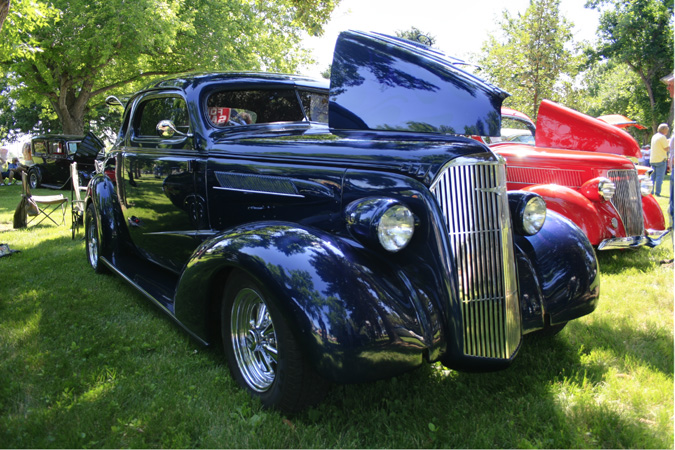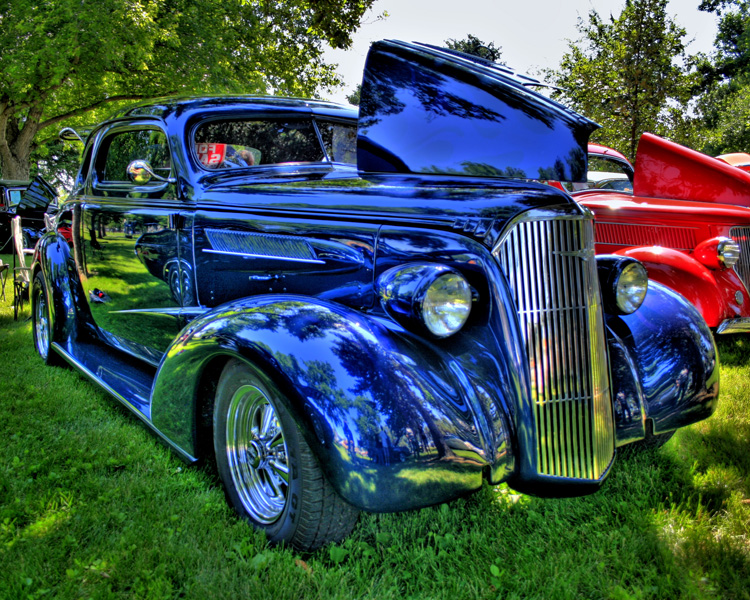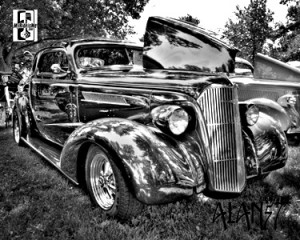Artistic Photo Effect Applied to Hot Rods
A person seeing my photography for the first time usually pauses for a moment, gazing, trying to understand just what it is they are looking at. I start to smile, knowing what is coming next. I say, “No…It’s a photograph”. The reply is almost always, “Really, I thought this had been airbrushed or something.”
The beauty of a well-designed automobile, truck, or, motorcycle inspires me to photograph them. I have a true appreciation for all the time and effort needed to bring a vehicle to a prime conditioned state. I see photography as a means of permanently recording that beauty.
When I first began searching the internet for a more artistic type of photography, I came across a series of photographs from Trey Ratcliff at the website: www.flickr.com/photos/stuckincustoms. Trey produces amazing photographs with HDR, a computer generated enhancement tool. To fully understand all the nuances of HDR, check out the website, www.HDR.com.
The HDR technique I use blends several photos together bringing to life the color and texture that is seen, but not recorded by a single photograph. Every reflection, color, and shadow is enhanced to a degree that emulates what the human eye comprehends.
To produce a finished photo, I begin by taking a minimum of three shots of my subject from a tripod, each at a different exposure setting. During bright days, the exposures are set at a full stop apart; and on more overcast days, I work with about a 1/3 stop. (in case you’re like me and needed to know more about “f-stop or what’s a “full stop”, check this wikopeida reference)
These next 3 shots show the three variations of exposures:
(you can click on these photos to see them full size. The change from one to the next is subtle withou studying them.)
Shooting from a tripod insures that the three shots line up when it comes time to merge them together.
Exposure blending takes these three shots and combines all of the highlights and shadows together, improving the overall tonal range of light and dark. The blending is done with the HDR (High Dynamic Range) software. Notice the subtle differences between the 3 shots above and the blended photo shown here:
At this point, it is time to add the final artistic details. This step allows me the freedom to “colorize” the photo. “Colorization” involves utilizing software like Adobe Photoshop to break down a photograph to its individual components and then enhance the colors.
1. First, I address the TONE of the photo by balancing overall lightness and darkness. I want to able to see details in the shadows, but not blast the sky to complete white.
2. Next, I address the COLOR saturation and temperature (the warmth or coolness of the photo) to bring out highlights. For this process I use the “Image Adjustments” feature of Photoshop.
3. Finally, I use the software to clean up small details as some colors may not look right after the other changes have been made, in other words, they may look “fake” or “brassy”. For example, if the grass around the car appears too green, I would tone down the green or yellow. If the chrome is reflecting too much of the sky, I would tone down the blue.
Throughout the colorization process, it helps to visualize what you want in the final photograph.
Every photo has to be treated individually-some photos scream for over-the-top colorization, while others may need all color removed, producing a dramatic effect in black and white.
During a car show, I typically take 300 to 500 shots. I really need to work with all the photos to see just what is going to be usable. Out of all of the blended shots, maybe a 100 or so are run through Photoshop to bring out all the details you see in the finished product. Photos that may have looked promising in the beginning of the process can turn out uninspiring, while shots that didn’t look so good to begin with can really turn out well!
The rewards for taking time to produce something special can really pay off! Car owners never tire of looking at great design. The HDR photo technique I use sets my photos apart from the rest, and keeps car lovers coming back for more. In addition, the personal satisfaction I get from seeing the enjoyment of others drives me to continue to produce my style of photographs.
Alan57
Alan’s Home page:www.alan57.com
Let’s give Alan a warm welcome to MyRideisMe.com. If anyone else would like to share their knowledge of photography or hot rod folklore, please get in touch. Thanks Alan!














Very nice article! Always interested in learning new photo and video techniques. More!